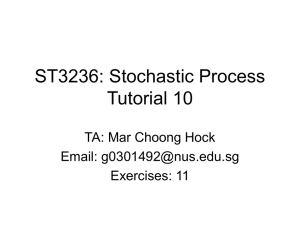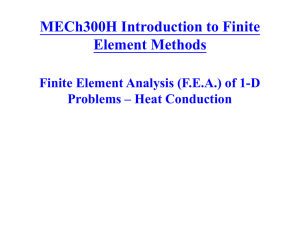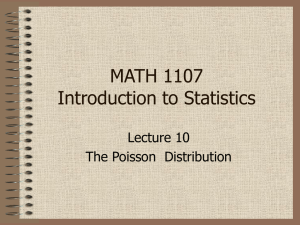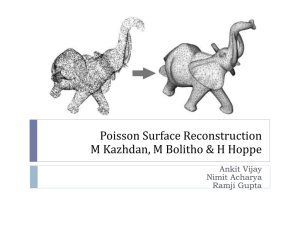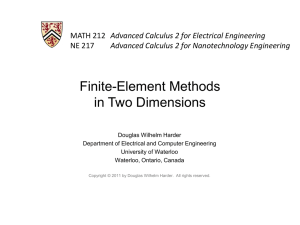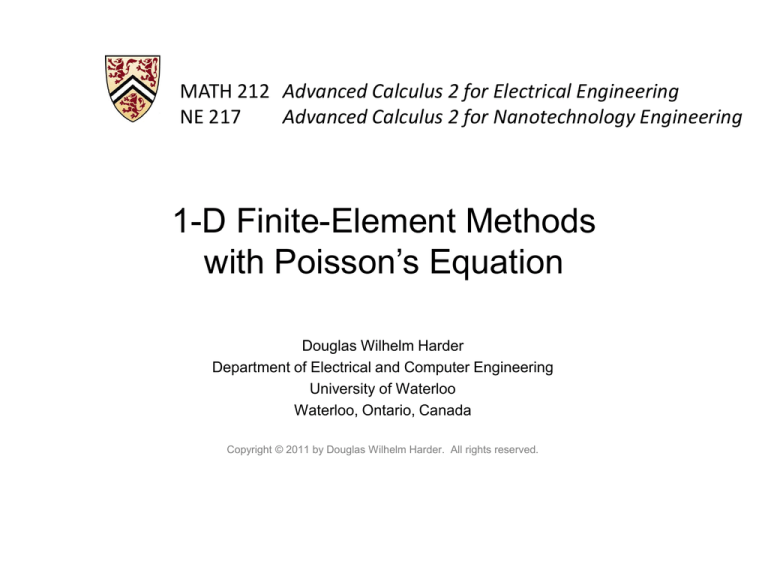
MATH 212 Advanced Calculus 2 for Electrical Engineering
Advanced Calculus 2 for Nanotechnology Engineering
NE 217
1-D Finite-Element Methods
with Poisson’s Equation
Douglas Wilhelm Harder
Department of Electrical and Computer Engineering
University of Waterloo
Waterloo, Ontario, Canada
Copyright © 2011 by Douglas Wilhelm Harder. All rights reserved.
1-D Finite-element Methods with Poisson’s Equation
Outline
This topic discusses an introduction to finite-element methods
– Review of Poisson’s equation
– Defining a new kernel V(x)
– Approximate solutions using uniform test functions
2
1-D Finite-element Methods with Poisson’s Equation
Outcomes Based Learning Objectives
By the end of this laboratory, you will:
– Understand how to approximate the heat-conduction/diffusion and wave
equations in two and three dimensions
– You will understand the differences between insulated and Dirichlet
boundary conditions
3
1-D Finite-element Methods with Poisson’s Equation
The Target Equation
Recall the first of Maxwell’s equations (Gauss’s equation):
E
0
If we are attempting to solve for the underlying potential function,
under the assumption that it is a conservative field, we have
2u
0
This is in the form of Poisson’s equation
4
1-D Finite-element Methods with Poisson’s Equation
The Target Equation
In one dimension, this simplifies to:
x
d2
u x
2
dx
0
Define:
x
d2
V x 2 u x
dx
0
def
and thus we are solving for
V x 0
5
1-D Finite-element Methods with Poisson’s Equation
The Integral
If V x 0 , it follows that
f x V x 0
for any test function f(x) and therefore
b
f x V x dx 0
a
Substituting the alterative definition of V(x) into this equation, we get
x
d2
f
x
u
x
a dx2 0 dx 0
b
6
1-D Finite-element Methods with Poisson’s Equation
The Integral
Consider the first test function f1(x) :
x3
b
x
d2
d2
a f 1 x dx 2 u x dx x dx 2 u x 0 dx 0
1
7
1-D Finite-element Methods with Poisson’s Equation
Integration by Parts
Again, take
x
d2
f
x
u
x
a dx2 0 dx 0
but before we apply integration by parts, expand the integral:
b
b
x
d2
f
x
u
x
dx
f
x
a dx2 a 0 dx 0
b
Everything in the second integral is known: bring it to the right:
b
x
d2
a f x dx2 u x dx a f x 0 dx
b
8
1-D Finite-element Methods with Poisson’s Equation
Integration by Parts
The left-hand integral is no different from before,
b
b
x
d2
f
x
u
x
dx
f
x
a dx2 a 0 dx
and performing integration by parts, we have
x
d
d
d
f
x
u
x
f
x
u
x
dx
f
x
dx
0
dx
a a dx
dx
a
b
b
b
x
d
d
d
d
f b u x f a u x f x u x dx f x
dx
dx
dx
dx
dx
0
a
a
x b
x a
b
b
9
1-D Finite-element Methods with Poisson’s Equation
Integration by Parts
First, substituting in the first test function:
b
b
x
d2
f
x
u
x
dx
f
x
a 2 d 2 x a 2 0 dx
x x1 x x3
which yields
x3
x3
1
1
1 x
dx
d
d
d
d
f
x
u
x
f
x
u
x
f
x
u
x
dx
f
x
2
2
2 3
2 1
dx
dx
dx
dx
0
x1
x1
x x3
x x1
10
1-D Finite-element Methods with Poisson’s Equation
The System of Linear Equations
Again, recall that we approximated the solution by unknown
piecewise linear functions:
x x1
x x2
u
u
2
1 x x
x2 x1
1 2
x x2
x x3
u3
u2
x3 x2
u x x2 x3
x xn
x xn 1
u
u
n
n 1 x x
xn xn 1
n 1
n
x1 x x2
x2 x x3
xn 1 x xn
x xk 1
x xk
uk 1
where we define uk x uk
on xk x xk 1
xk xk 1
xk 1 xk
def
11
1-D Finite-element Methods with Poisson’s Equation
Unequally Spaced Points
Recall that we approximated the left-hand integral by substituting the
piecewise linear functions to get:
b
x
d2
a fk x d 2 x u x dx a fk x 0 dx
b
k 1
x
d2
dx
x
u
x d 2 x x 0 dx
k 1
k 1
xk 1
x
uk uk 1 k 1 x
uk 1 uk
dx
2
2
xk xk 1 xk 1 0
xk 1 xk
x
1
1
1
2
u
2
k 1
x
x
k 1
xk xk 1 xk 1 xk
k
1
2
u
k 1
xk 1 xk
k 1
x
dx
uk 1
0
xk 1
x
12
1-D Finite-element Methods with Poisson’s Equation
Integration by Parts
That is, our linear equations are:
1
1
1
1
u
u
k 1
k 1
x
x
x
x
x
x
k 1
k 1
k 1
k
k
k
xk 1 xk
1 k 1 x
dx
uk 1
2 xk 1 0
x
This time, let’s take an actual example
13
1-D Finite-element Methods with Poisson’s Equation
Integration by Parts
Consider the equation
d2
u x 2 u x sin 4 x
dx
with the boundary conditions
2
u(0) = 0
u(1) = 0
14
1-D Finite-element Methods with Poisson’s Equation
Integration by Parts
The solution to the boundary value problem
d2
u x 2 u x sin 4 x
dx
2
u(0) = 0
u(1) = 0
is the exact function
u x
1
1
2
4
3
x
x
1
4
5cos
x
cos
x
16
2
15
1-D Finite-element Methods with Poisson’s Equation
Integration by Parts
We know in one dimension if the right-hand side is close to zero, the
solution is a straight line
d2
2
u x 2 u x sin 4 x
dx
Thus, choose 9 interior points with a focus on the centre:
>> x_uneq = [0 0.16 0.25 0.33 0.41 0.5 0.59 0.67 0.75 0.84 1];
16
1-D Finite-element Methods with Poisson’s Equation
Integration by Parts
We will compare this approximation with the approximation found
using 9 equally spaced interior points
– The finite difference approximation
>> x_eq = 0:0.1:1;
17
1-D Finite-element Methods with Poisson’s Equation
The Test Functions
The function to find the approximations is straight-forward:
function [ v ] = uniform1d( x, uab, rho )
n = length( x ) - 2;
idx = 1./diff(x);
M = diag( -(idx( 1:end - 1 ) + idx( 2: end )) ) + ...
diag( idx( 2:end - 1 ), -1 ) + ...
diag( idx( 2:end - 1 ), +1 );
b
b = zeros ( n, 1 );
int( rho, a, b ) approximates
x dx
for k = 1:n
b(k) = 0.5*int( rho, x(k), x(k + 2) );
end
a
b(1)
= b(1)
- idx(1)*uab(1);
b(end) = b(end) - idx(end)*uab(end);
v = [uab(1); M \ b; uab(2)];
end
18
1-D Finite-element Methods with Poisson’s Equation
The Test Functions
The right-hand function of
2
d
2u x 2 u x sin 4 x
dx
is also straight-forward:
function [ u ] = rho( x )
u = sin( pi*x ).^4;
end
19
1-D Finite-element Methods with Poisson’s Equation
The Equations
Thus, we can find our two approximations:
>>
>>
>>
>>
>>
x_eq = (0:0.1:1)';
plot( x_eq, uniform1d( x_eq, [0, 0], @rho ), 'b+' );
hold on
x_uneq = [0 0.16 0.25 0.33 0.41 0.5 0.59 0.67 0.75 0.84 1]';
plot( x_uneq, uniform1d( x_uneq, [0, 0], @rho ), 'rx' );
20
1-D Finite-element Methods with Poisson’s Equation
The Equations
It is difficult to see which is the better function, therefore create a
function storing the actual solution (as found in Maple):
function u = u(x)
u = -1/16*(
(cos(pi*x).^4 - 5*cos(pi*x).^2 + 4)/pi^2 +
3*x.*(x - 1)
);
end
...
...
...
21
1-D Finite-element Methods with Poisson’s Equation
The Equations
Instead, plotting the errors:
>>
>>
>>
>>
>>
x_eq = 0:0.1:1;
plot( x_eq, uniform1d( x_eq, [0, 0], @rho ) - u(x_eq), 'b+' );
hold on
xnu = [0 0.16 0.25 0.33 0.41 0.5 0.59 0.67 0.75 0.84 1];
plot( x_uneq, uniform1d( x_uneq, [0, 0], @rho ) - u(x_uneq), 'rx' );
22
1-D Finite-element Methods with Poisson’s Equation
Integration by Parts
Understanding that the right-hand side has a greater influence in the
centre,
d2
2
u x 2 u x sin 4 x
dx
appropriately changing the sample points yielded a significantly
better approximation
23
1-D Finite-element Methods with Poisson’s Equation
Summary
In this topic, we have generalized Laplace’s equation to Poisson’s
equation
– Used the same uniform test functions
– We looked at a problem for which there is an exact solution
• Changing the points allowed us to get better approximations
24
1-D Finite-element Methods with Poisson’s Equation
What’s Next?
The impulse function (the derivative of a step function) is difficult to
deal with…
We will next consider test functions that avoid this…
– The test functions will be tents
– This generalizes to higher dimensions
25
1-D Finite-element Methods with Poisson’s Equation
References
[1] Glyn James, Advanced Modern Engineering Mathematics, 4th Ed.,
Prentice Hall, 2011, §§9.2-3.
26
1-D Finite-element Methods with Poisson’s Equation
Usage Notes
•
•
These slides are made publicly available on the web for anyone to use
If you choose to use them, or a part thereof, for a course at another
institution, I ask only three things:
– that you inform me that you are using the slides,
– that you acknowledge my work, and
– that you alert me of any mistakes which I made or changes which you make, and
allow me the option of incorporating such changes (with an acknowledgment) in
my set of slides
Sincerely,
Douglas Wilhelm Harder, MMath
dwharder@alumni.uwaterloo.ca
27



